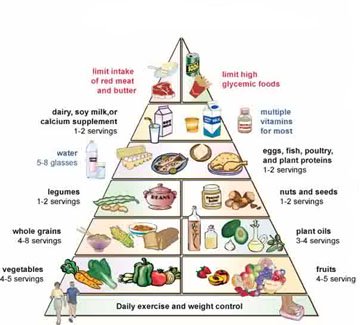|
The New Food Pyramid
The new food guide pyramid became available from the US Federal Government in January 2005. And, in April, 2005 The USDA released it's interactive dietary guidleines,
Mypyramid.
Apparently we were long overdue for an updated version of the food pyramid. The old one consisted of the "Four Basic Food Groups" that you remember growing up with as a kid. But so many kids today are faced with weight problems due to poor eating habits and lack of exercise. We are all aware in this modern day that some types of fat are healthy and can even reduce certain risks of cardiovascular disease. There is very little scientific evidence that it is beneficial to have a high carbohydrate intake. All you have to do is take a look at the multitude of "low carb" products on your grocer's shelves. For more than a decade the former USDA pyramid has proven to be outrageously flawed and highly misleading. Repeat after me, not all fats are bad and not all complex carbs are good. Be aware of your choice of fats and carbohydrates. For example, restrict trans fats that can clog arteries. These bad fats are found in foods such as margarines and snack foods. Increase fiber-rich foods such as fresh fruits, fresh vegetables, and whole grain breads and cereals. Even the specific food pyramids for Seniors, and Mediterranean foods emphasize the high fiber way! Consume at least three one-ounce servings of whole grains every day which is quite easy to do. Try switching from white to whole grain bread for your sandwich at lunchtime and have a bowl of whole grain cereal at breakfast rather than the sugar-laden, empty calorie brand you currently stock in the pantry. Eat at least five servings each day of fruits and vegetables. It's this simple. If you have a half cup of orange juice at breakfast, an apple with lunch and a salad along with a cooked vegetable with supper you have met the requirements. Check all of our simple, delicious, and healthful high fiber recipes. Since salt is linked to high blood pressure, limit your salt intake to about one teaspoon a day since it is linked to high blood pressure. If you enjoy alcoholic beverages, do so in moderation with your doctor's permission. Basically, you need to eat more unprocessed plant foods, more fish, beans, nuts, and seeds...that sounds an awful lot like high fiber. Can this be?
|